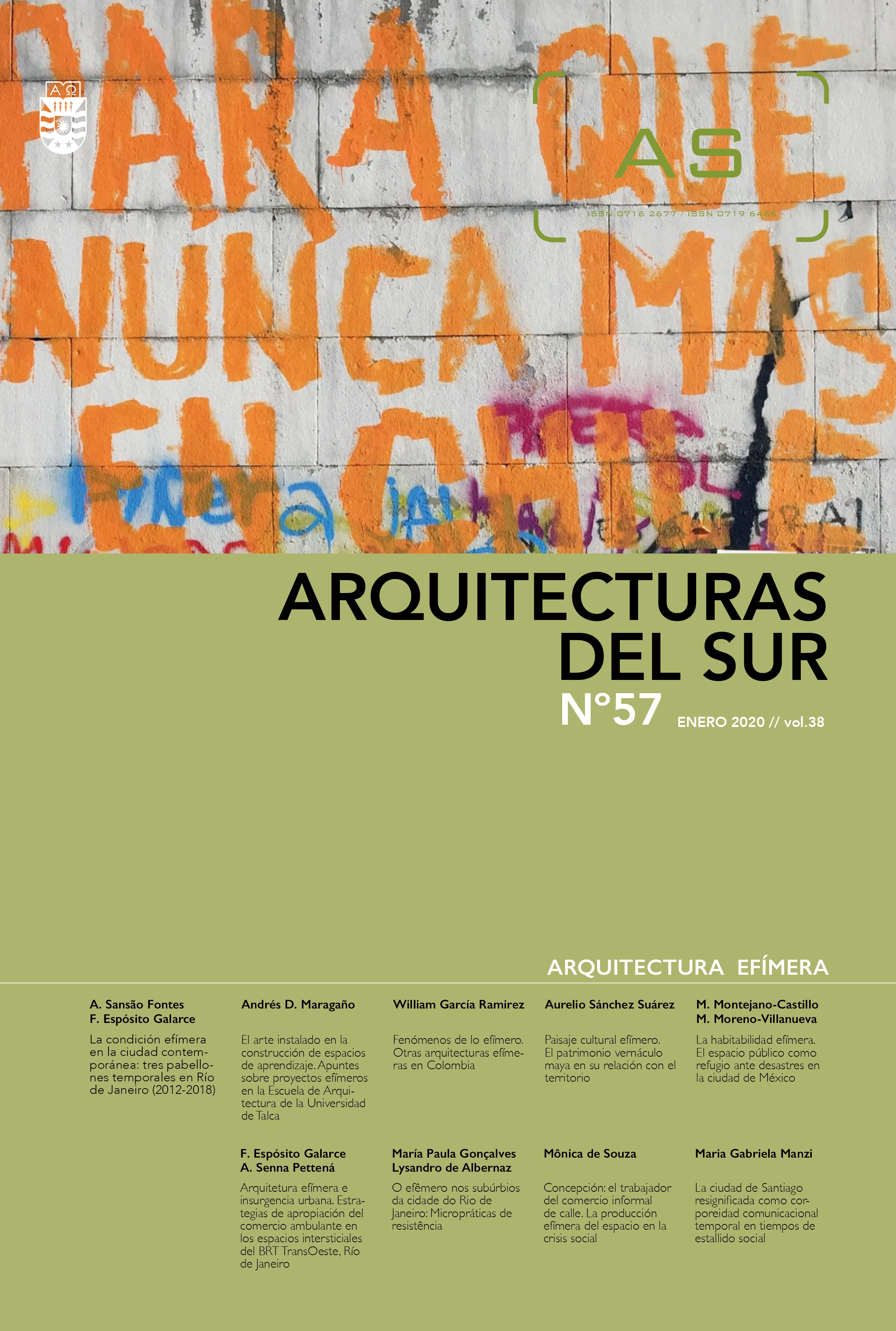Ephemeral cultural landscape. The vernacular Mayan heritage in its relationship with the territory
DOI:
https://doi.org/10.22320/07196466.2020.38.057.04Keywords:
Landscapes, culture, ephemeral architecture, vernacular architecture, tabladosAbstract
For the Maya the subjectivation of things is essential in their philosophy of inhabiting the territory; therefore, its vernacular architecture also assumes this perception. To arrive at this precept, a research project was developed that sought to understand the processes of transmission of knowledge to tie its vernacular architecture, in a study that involved methodologies of both the area of architecture and anthropology. In the process of surveying architectural data, he noticed this process of life of the houses of the Maya, which, being mostly perishable materials, reach a time of life, but at the same time they are moored coming alive New houses for new families. The above makes the vernacular architecture of the ephemeral Maya. The knowledge to tie-up has also been used to create another much more ephemeral architecture: The tablados for bullfights; being these tablados linked to the patron saint, its existence is only one week, forming an ephemeral cultural landscape typical of the Mayan populations. This quality of the ephemeral makes Mayan vernacular architecture an essential characteristic, but they are also a vital part of its existence as it is the learning scenarios of knowledge to tie.
Downloads
References
APLIN, G. World Heritage Cultural Landscapes, International Journal of Heritage Studies, 2007. 13:6, pp. 427-446.
CHANDIA - JAURE, R. Estrategias de gestión sostenible del territorio: cultura de riego alto-andino del desierto de Atacama. Revista AUS, 2013, (13), pp. 5-10.
CONVENIO EUROPEO DEL PAISAJE (2000), Consejo de Europa [acceso octubre 2013]. Disponible http://www.cidce.org/pdf/Convenio%20Paisaje.pdf
DOCUMENTO DE NARA SOBRE LA AUTENTICIDAD. ICOMOS. 1994.
GALINDO GONZÁLEZ, J. y SABATÉ BEL, J. El valor estructurante del patrimonio en la transformación del territorio. En Apuntes, 2009, vol. 22, no. 1, pp. 20-33.
GUERRERO BACA, L. F. (coord.) Patrimonio construido con tierra, Universidad Autónoma Metropolitana, UNESCO. 2007.
GÓMEZ ARRIOLA, L. I. El papel de las comunidades locales en un paisaje cultural: el paisaje agavero de Tequila, en Revista PH, 2015, no. 87, pp. 128-149.
HUESO, A., CASCANT, M. Metodologías y Técnicas Cuantitativas de Investigación, Cuadernos docentes en procesos de desarrollo, 2012, No. 1, Universidad Politécnica de Valencia.
LEY FEDERAL SOBRE MONUMENTOS Y ZONAS ARQUEOLÓGICOS, ARTÍSTICOS E HISTÓRICOS, Nueva Ley publicada en el Diario Oficial de la Federación el 6 de mayo de 1972. Última reforma publicada DOF 16-02-2018.
LÓPEZ MORALES, F. J. Arquitectura vernácula en México, Editorial Trillas, México. 1987.
MUÑOZ-PEDREROS, A. La evaluación del paisaje: una herramienta de gestión ambiental en Revista Chilena de Historia Natural, 2004, no. 77, pp.139-156.
PÁRAMO MORALES, D. 015), La teoría fundamentada (Grounded Theory), metodología cualitativa de investigación científica, Pensamiento & Gestión, 2015, núm. 39, pp. 119-146.
PRIETO, V. (coord.) Vivienda campesina en México, Secretaría de Asentamientos Humanos y Obras Públicas, México. 1987.
RODRÍGUEZ FIGUEROA, A. B. y AVENDAÑO ENCISO, A. La vegetación y la vivienda nahua de Santa Ana Tlacotenco, Milpa Alta, México, Bitácora, 2015, núm. 31, pp. 28-37.
SÁNCHEZ SUÁREZ, A. La casa maya contemporánea. Usos, costumbres y configuración espacial, en Península, 2006, 2(1) pp. 81-105.
SÁNCHEZ SUÁREZ, A. Patrimonio inmaterial y material de la corrida de toros en los pueblos mayas, en Artesanías de América, 2009, no. 69, pp. 213-229.
SÁNCHEZ SUÁREZ, A. Entre lo material e inmaterial y dependiente de lo natural, en Horizontes Revista de Arquitectura, 2013, no. 5, pp. 35-40.
SÁNCHEZ SUÁREZ, A. El ruedo tradicional en Campeche y su impacto ambiental, en Horizontes Revista de Arquitectura, 2014, no. 6, pp. 23-30.
SÁNCHEZ SUÁREZ, A. Los tablados: arquitectura vernácula efímera de los pueblos mayas, en Arquitecturas del Sur, 2015, vol. 33, no. 47, pp. 26-37.
SÁNCHEZ SUÁREZ, A. (Coord.) Xa’anil naj. La gran casa de los mayas, Universidad Autónoma de Yucatán. 2018.
TERÁN, S. y RASMUSSEN, Ch. La milpa de los mayas, UNAM, México. 2009.
UNESCO-ICOMOS, 2009, World Heritage Cultural Landscapes Documentación Centre [acceso octubre 2013]. Disponible http://www.icomos.org/landscapes/Declarados%20PM%20y%20bibliograf%EDa.pdf
WAUCHOPE, R. Modern Maya Houses. Washington: Carnegie Institution of Washington, publicación 502. 1938.
Downloads
Published
How to Cite
Issue
Section
License
The content of the articles published in each issue of Arquitecturas del Sur is the sole responsibility of the authors and does not necessarily represent the opinion of University of the Bío-Bío.
The authors will maintain their copyright; however, they will guarantee the journal the right to first publication and dissemination of their work. The publication of the article in Arquitecturas del Sur will be subject to the Creative Commons International license (CC BY-SA) that allows others to adapt: remix, transform and build on the material for any purpose, even commercially; share: copy and redistribute the material in any medium or format, as long as the authorship and first publication in this journal are acknowledged by citing them correctly, and their new contributions are under a license with the same terms.














 Programa de Información Científica/Concurso Fondos de Publicación de Revistas Científicas 2018/ Proyecto Mejoramiento de Visibilidad de Revistas UBB (Código:FP180007)
Programa de Información Científica/Concurso Fondos de Publicación de Revistas Científicas 2018/ Proyecto Mejoramiento de Visibilidad de Revistas UBB (Código:FP180007) 
